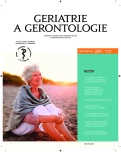Chest pain in a patient with thoracic aorta dissection
Authors:
S. Demeterová; P. Weber; Š. Bohatá; R. Šreflová; P. Trčka
Published in:
Geriatrie a Gerontologie 2015, 4, č. 2: 103-107
Category:
Case Reports
Overview
Chest pain is a fairly common symptom of internal medicine. It has a wide range of possible causes from absolutely trivial to life threatening. One of the less frequent, but clinically severe reasons of chest pain is the dissection of the thoracic aorta. The authors describe the clinical course of this disease, including the diagnosis and therapy until the surgical solution with prosthesis for the specific patient and more broadly discuss this issue in general. The team of authors wants to draw attention to the continued need to consider this serious diagnosis, which should be taken into account whenever a sudden chest pain appears and to the rather poor symptomatology of the disease in the elderly. Alongside the need for a proper and adequate diagnosis in the elderly, it draws attention not only to the risk of dissection of the ascending aorta, but also points out to the possibilities of a successful solution.
Keywords:
chest pain – differential diagnosis – thoracic aorta dissection – late elderly
Sources
1. Souček M, Špinar J, Vorlíček J, a kol.: Vnitřní lékařství. Praha, Brno: Grada Publishing, Facta Medica, MuniPress, 2011.
2. Kasper DL, Fauci AS, Longo DL et al.: Harrison‘s Principles of Internal Medicine. 17th edition, New York, USA: McGraw-Hill Medical Publishing Division 2008.
3. Smith AD, Schoenhagen P.: CT imaging for acute aortic syndrome. Cleve Clin J Med 2008; 75(1), 7–9, 12, 15–7.
4. Braunwald E, Zipes DP, Libby P.: Heart disease, a textbook of cardiovascular medicine. 6th edition. Philadelphia: W. B. Saunders Comp 2001.
5. Hall JB, Schmidt GA, Wood LDH et al.: Principles of critical care. 3. ed. New York: McGraw-Hill, Medical Publishing Division 2005.
6. Pathy MSJ, Sinclair AJ, Morley JE.: Principles and practice of geriatric medicine. 4th ed. Chichester, UK: Wiley 2006.
7. Duthie EH, Katz PR, Malone ML: The practice of geriatrics. 4th ed., Philadelphia: Saunders Elsevier 2007.
8. Hegyi L, Krajčík Š, et al.: Geriatria. Bratislava: Herba 2010.
9. Matějovská Kubešová H a kol.: Akutní stavy v geriatrii. Praha: Galén 2009.
10. Hoch J: Speciální chirurgie. Praha: Maxdorf 2011.
11. Češka R: Interna. Praha: Triton 2010.
12. Kalvach Z, Zadák Z, Jirák R a kol.: Geriatrie a gerontologie. Praha: Grada 2008.
13. Miller DC, Doroghazi RM, Slater EE: Aortic dissection. New York: McGraw-Hill 1983.
14. Ďuriš I, Hulín I, Bernadič M: Princípy internej medicíny. Bratislava: SAP 2001.
15. Kadappu KK, Rajaratnam R, Premawardhana U, et al.: Unusual cause of exertional chest pain. Intern Med J 2007; 37(12): 834–835.
16. Klener P, a kol.: Vnitřní lékařství. 2. doplněné vydání. Praha: Galén 2001.
17. Piťha J, a kol.: Akutní stavy na interním oddělení. Praha: Triton 2003.
18. Bhalla S, West OC: CT of nontraumatic thoracic aortic emergencies. Semin Ultrasound CT MR 2005; 26(5): 281–304.
19. Castaner E, Andreu M, Gallardo X, et al.: CT in nontraumatic acute thoracic aortic disease: typical and atypical feature and complications. Radiographics 2003; 23: Spec. No.: 93–110.
20. Ledbetter S, Stuk JL, Kaufman JA.: Helical (spiral) CT in the evaluation of emergent thoracic aortic syndromes. Traumatic aortic rupture, aortic aneurysm, aortic dissection, intramural hematoma, and penetrating atherosclerotic ulcer. Radiol Clin North Am 1999; 37(3): 575–589.
21. Rist C, Johnson TR, Becker CR, et al.: New applications for noninvasive cardiac imaging: dual-source computed tomography. Eur Radiol 2007; 17: Suppl. 6: 16–25.
22. Vignon P, Gueret P, Vedrinne JM, et al.: Role of transesophageal echocardiography in the diagnosis and management of traumatic aortic disruption. Circulation 1995; 92(10): 2959–2968.
23. Namai A, Sakurai M: Conservative t-1147.
24. Zeman M a kol.: Speciální chirurgie. Praha: Galén 2001.
25. Doss M, Balzer J, Martens S et al.: Surgical versus endovascular treatment of acute thoracic aortic rupture: a single-center experience. Ann Thorac Surg 2003; 76(5): 1465–1469.
26. Lebl DR, Dicker RA, Spain DA, et al.: Dramatic shift in the primary management of traumatic thoracic aortic rupture. Arch Surg 2006; 141(2): 177–180.
27. Dagenais F, Normand JP, Turcotte R, et al.: Changing trends in management of thoracic aortic disease: where do we stand with thoracic endovascular stent grafts? Can J Cardiol 2005; 21(2): 173–178.
28. Karmy-Jones R, Hoffer E, Meissner MH, et al.: Endovascular stent grafts and aortic rupture: a case series. J Trauma 2003; 55(5): 805–810.
Labels
Geriatrics General practitioner for adults Orthopaedic prostheticsArticle was published in
Geriatrics and Gerontology

2015 Issue 2
Most read in this issue
- Chronic pancreatitis in the old age
- Nutritional support in dementia patiens
- Chronic heart failure – specifics of treating seniors
- Chest pain in a patient with thoracic aorta dissection
